Bermuda grass is prized for its excellent resistance to drought and extreme temperatures as well as its ability to sustain severe use and swiftly recover. Due to a mix of features, Bermuda grass is a great pick for lush lawns among homeowners in the United States.

But its extensive use is constrained by the grass’s climate constraints. Because of this, many people may find that their Bermuda grass is turning brown. Knowing what causes this may help your lawn flourish. Let’s take a look at some of the main reasons Bermuda grass dies and what you can do to avoid it.
1. It’s Too Cold
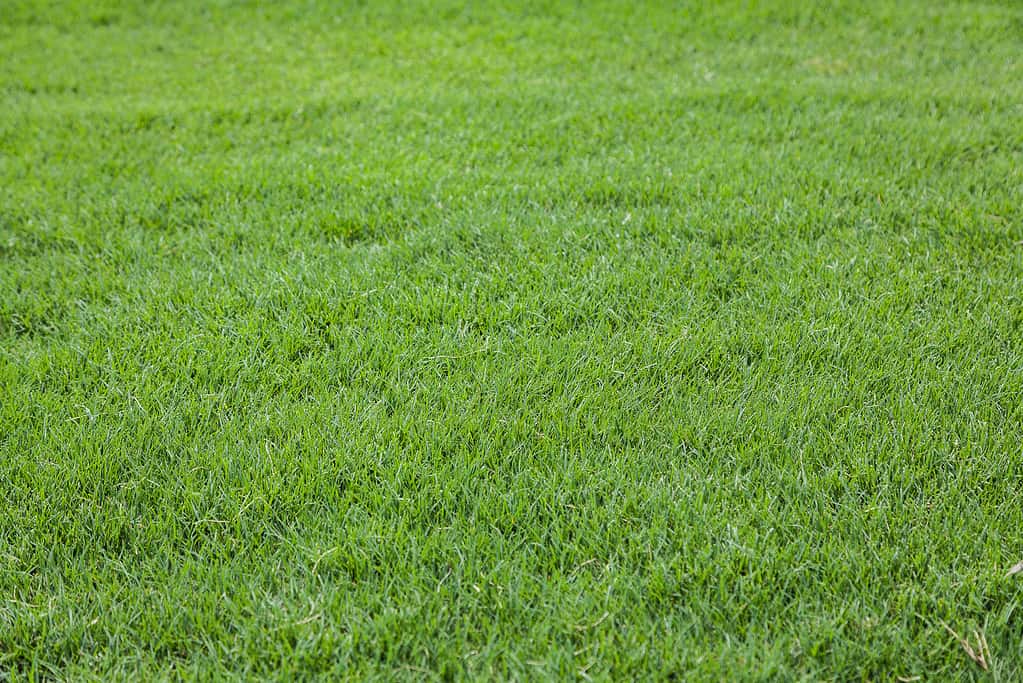
Bermuda grass can look incredible if cared for properly.
©iStock.com/JPratt
Since Bermuda grass is a warm-season grass, it does not grow during the winter. The grass normally becomes brown during colder months. Typically toward the end of autumn. fall, becoming green at the beginning of spring.
The grass turns inactive when the soil temperature drops below 55 degrees Fahrenheit. It begins to green up in the spring and thrives when the soil temperature is consistently around 65 degrees Fahrenheit and higher.
Bermuda grass can enter this stage of what some would consider hibernation, sooner than anticipated if there is an unusual cold wave of weather in the spring or the fall.
2. Dense Soil
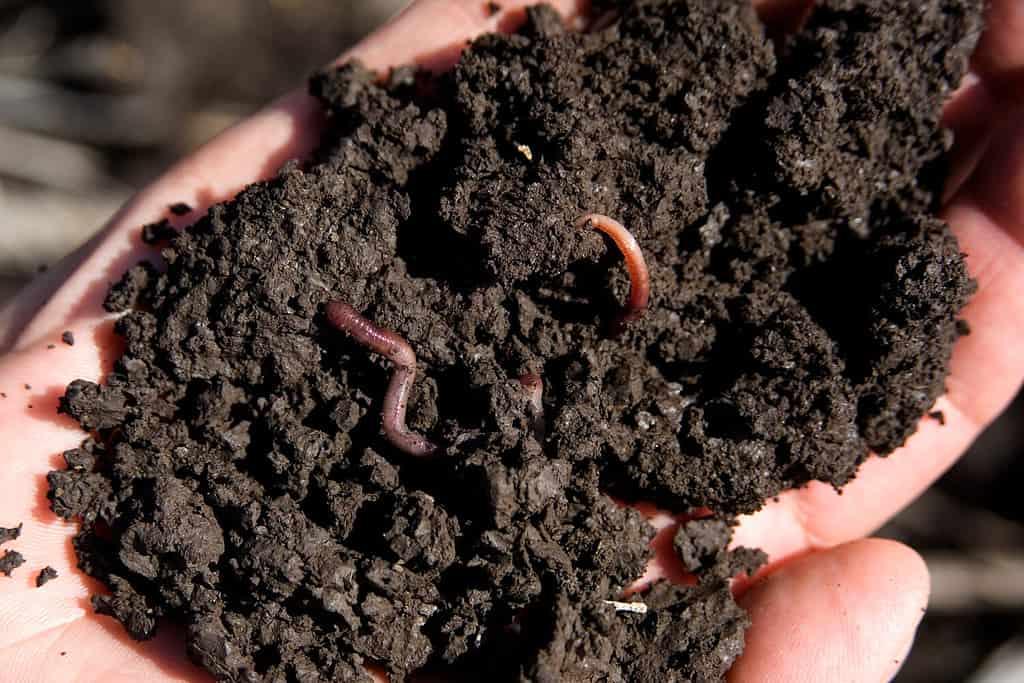
If the soil is too compact, roots can’t breathe properly.
©Alf Manciagli/Shutterstock.com
The roots of this grass could suffocate if your soil becomes excessively compact. Bermuda grass is killed when the roots decay due to a lack of air and inadequate drainage. Lawns made of this type of grass require aeration in order to avoid soil compaction.
If the lawn doesn’t get enough water, brown circles or blotches may form on it. Water cannot penetrate deeply into the soil because of thatch. By dethatching your grass every year in the first weeks of spring, you can avoid thatch accumulation.
Bermuda grass can be hand-sprogged, which is effectively producing new grass blades by propagation, to quickly revitalize it as compacted soil forces the grass to start drying out more quickly and get brown spots.
3. Dollar Spot Fungus

Mycelia or mycelium or lawn fungus are other names for dollar spot fungus.
©Zaid Harith/Shutterstock.com
Bermuda grass develops brown areas due to dollar spot. It is a fungus illness spread by soil that is simpler to avoid than to treat. Even though it is a soil fungus, the roots are not disturbed. Brown is limited to the grass blades.
Bermuda grass turns brown because of dry soil. The issue that causes dollar spot to develop is that even though the grass’s roots are dry, fresh dew and humid air effectively cause it to decay from the top down.
By utilizing a nitrogen-rich fertilizer, dollar spot can be avoided. This task needs to be repeated every month. Furthermore, yearly measures must be made to guarantee that water penetrates the roots.
To do this, dethatch the grass in the first weeks of spring and core-aerate it by poking holes in it.
4. Not Enough Sunlight

Make sure any lawn you have gets plenty of sunshine.
©enjoy photo/Shutterstock.com
As you can expect with just about any plant, if it doesn’t get enough sun, it will die. Bermuda grass is no different. Bermuda grass sprigs that aren’t exposed to sunshine can crack.
Long blades with lengthened leaves that have become brown can be found growing in areas of indirect sunshine. Mowing at higher levels will help the grass maintain heat when it is growing in a place with not enough sunlight.
Long grass blades have the drawback of preventing sunlight from reaching the lower parts of the grass buds. Bermuda grass sprigs that aren’t exposed to sunshine can crack. Long blades with lengthened leaves that have become brown can be found growing in areas of indirect sunshine.
Bermuda grass requires six hours of direct sunlight per day on all surfaces. The lower portion of the grass is crowded out by blades taller than two inches, which causes it to become brown from the bottom upward.
Mowing allows the grass to recover by exposing the browning areas to sunshine.
5. Grass Disease

Rhizoctonia is identifiable due to the ring that appears.
©SingjaiStocker/Shutterstock.com
The most common culprit when Bermuda grass has a disease is Rhizoctonia, a fungus-causing pathogen. On warm-season grasses, such as Bermuda grass, it can be especially damaging. More so at the beginning of spring and the end of autumn when nighttime temperatures suddenly rise to above 70 degrees Fahrenheit.
When the evening temperature is over 60 degrees Fahrenheit, Bermuda thrives. It maintains the soil temperature at 65 degrees Fahrenheit or higher when paired with warm afternoon temperatures.
The Rhizoctonia fungus can become out of hand when nighttime temperatures rise to between 70 and 90 degrees Fahrenheit. If the growth is significant, it could be necessary to treat it with a fungicide, ideally, a liquid fungicide instead of a granular one, in order to get it in check.
When the browning expands or your lawn develops larger brown spots, those are signs of an illness. Browning is merely a result of irrigation issues in the area that is having trouble getting water. The likelihood of a fungal infection increases if the browning is spreading.
6. Spring Dead Spot
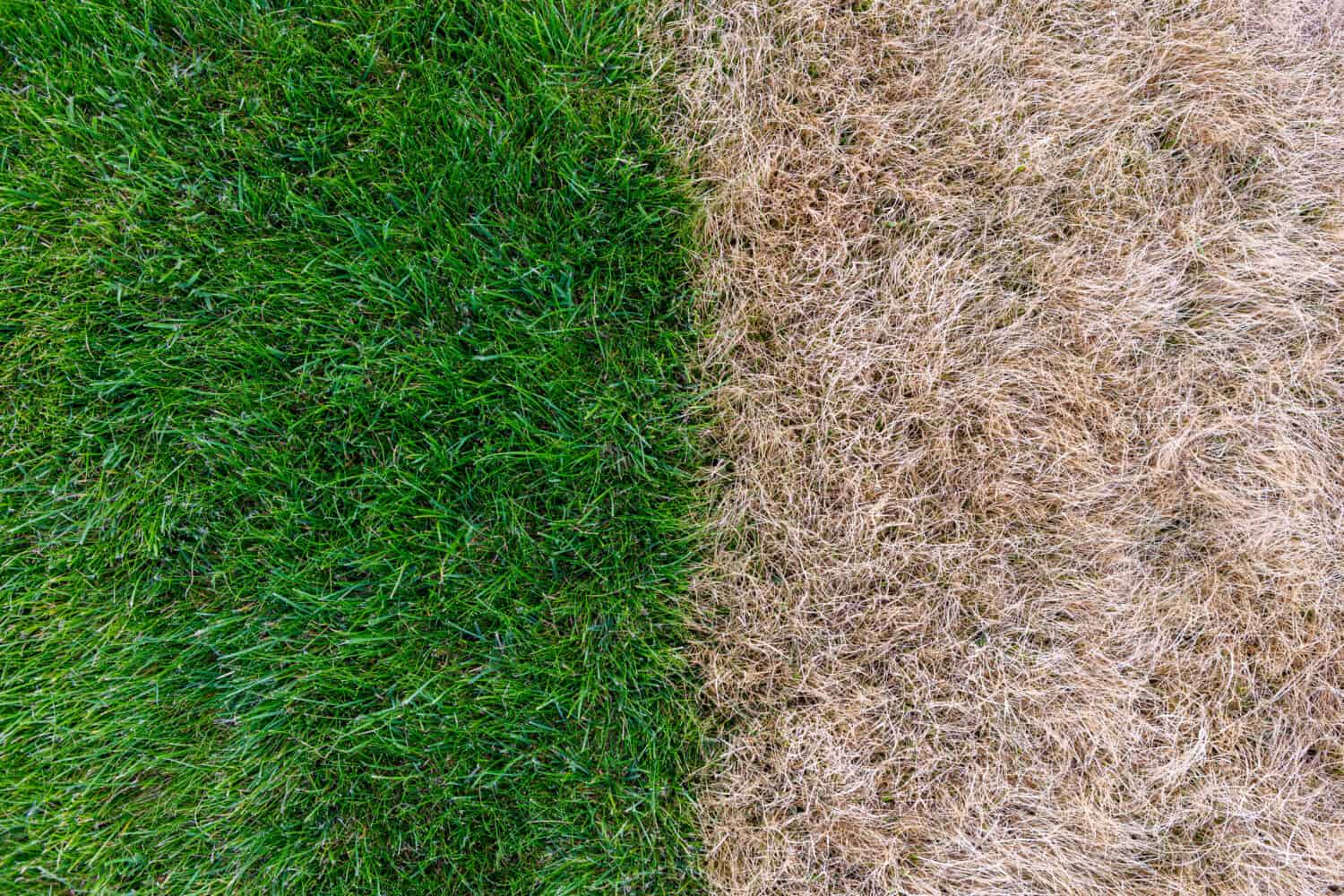
Spring dead spot causes Bermuda grass to brown.
©Sergey Gerashchenko/Shutterstock.com
A fungal disease called spring dead spot is limited to well-kept lawns. It is more susceptible to this fungal illness the more cautiously you fertilize. Finding it is simple. Bermuda grass develops brown circles as a result. Depending on how severe it is, it could appear to be bleaching.
Select a sprig of grass from the area where you observe brown dots to examine it. Bermuda grass’s entire root system rots from spring dead spot. the below-ground runners, crowns, stems, and underground roots.
What appears to be brown on the top will actually be black rot underneath. It only occurs frequently in the spring and in soils high in nitrogen. Using a fungicide in late autumn, when the grass becomes dormant, and rates of fertilizer application during the growth season must be balanced properly in order to eradicate the spring dead spot in Bermuda grass.
7. Insects
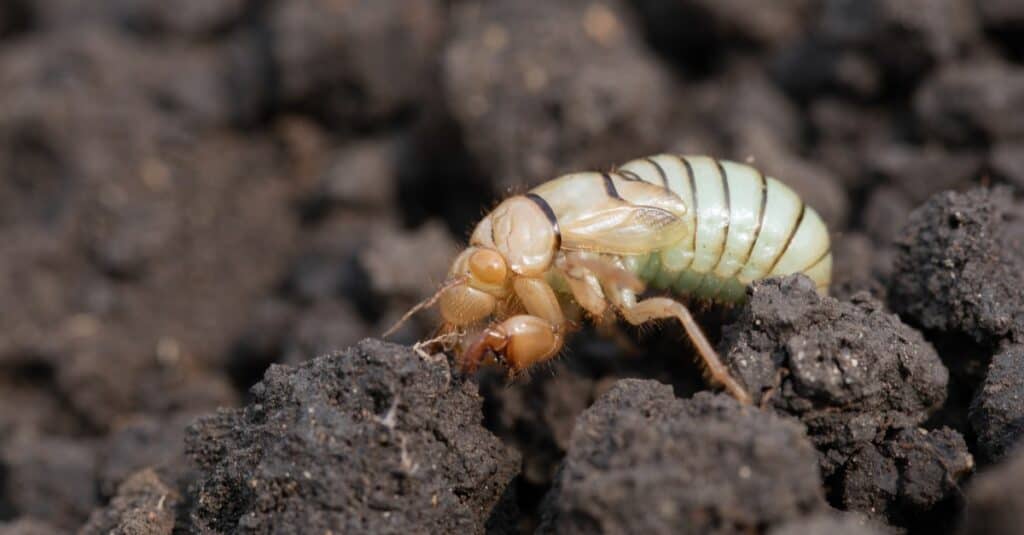
Mole crickets are small but mighty invaders of lawns and gardens.
©Olya Maximenko/Shutterstock.com
Damage from insects does happen to Bermuda grass lawns, albeit less frequently than some of those other issues. The most prevalent insect pests include mole crickets, worms, ground pearls, mites, Bermuda grass scales, and nematodes.
Depending on the species, the invader may strike right away and eat the blades and roots. Damage left by grazing insects or direct observation of insects can help identify if this is the source of the problem with your lawn.
Pest insects that burrow through the grass may cause concerns that are difficult to identify from other issues.
8. Fertilizer Burn
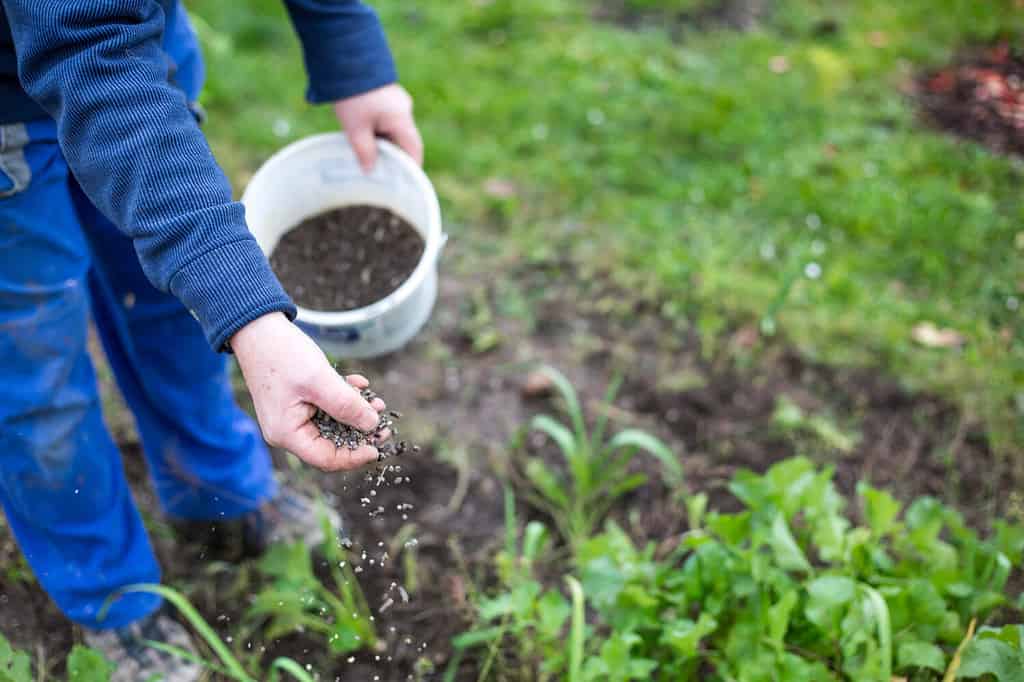
Fertilizer burns can happen on all types of grass.
©Simon Kadula/Shutterstock.com
When a lawn receives an excessive amount of fertilizer, this issue will arise. This is frequently caused by an excess of nitrogen. The yellowing and striping of the lawn are frequent results of fertilizer burn.
The discoloration often makes it easy to detect where the fertilizer was sprayed.
Increase watering to help drain out additional nutrients from the earth if fertilizer burn is detected. Throughout the summer, Bermuda grass yards require two to four pounds of nitrogen. The nitrogen rates may vary depending on the type of soil you have.
9. Nutrient Deficiencies

The only yellowing you want to see in your grass is from surrounding flowers.
©iStock.com/Larysa Pashkevich
Bermuda grass becoming yellow is most frequently caused by an iron or nitrogen deficit. These typical problems are likely to affect the whole property or significant portions of it. This helps distinguish vitamin shortages from smaller insect or disease-related marks.
Iron is a crucial component in the synthesis of chlorophyll. Chlorophyll not only makes the grass green but also aids in its ability to absorb sunlight. Iron deficiency is generally detected by green streaks on yellow blades in the spring.
How to Make Bermuda Grass Thrive

Bermuda grass is often spotted in new developments.
©aimful/Shutterstock.com
The desire of having a lush, green lawn could be a lot closer than you believe. Proper mowing, irrigation, and upkeep are the three major components that transform Bermuda grass growth into a lush lawn.
Mow Regularly
Mow Bermuda grass to an inch and a half high to make it fuller. Because the Bermuda grass will focus its efforts on horizontal dispersion instead of vertical development, trimming it short will result in a denser lawn. Either a rotary mower or a reel mower will work. To maintain your lawn appearing thick and healthy, mow around once each week.
Have a Watering Schedule
Bermuda grass benefits most from sporadic, deep soaking. Take a soil probe to check your irrigation level after moistening the soil to a depth of six inches. Don’t water again unless the grass displays signs of drought stress. Depending on the weather where you are, this can take between five and 10 days.
You might need to run the irrigation system in 30-minute to one-hour increments in order to avoid run-off while also making sure you’re watering sufficiently deep. The soil has time to soak up everything when it receives intermittent watering.
Wet roots don’t promote healthy grass growth. Reduce how much you water, if you notice muddy pools on the grass.
Control Unruly Weeds
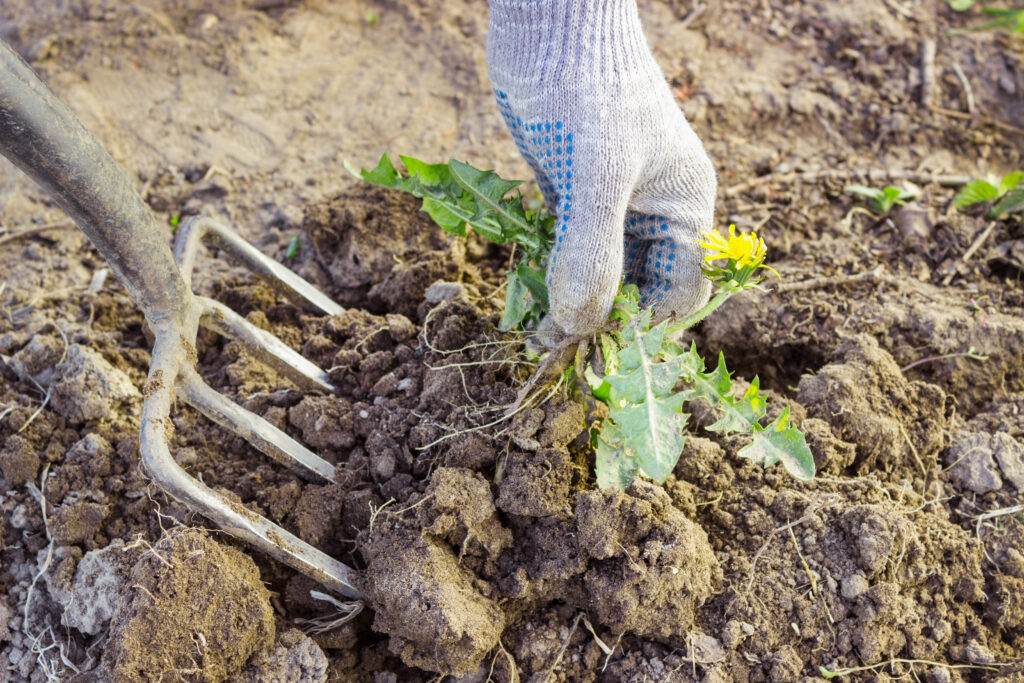
Weeding should be done before the grass turns green.
©Sever180/Shutterstock.com
Bermuda grass lawns will appear spotty and thin due to weeds. Pre-emergent herbicides should be used in the time from the middle of February and early March to prevent weed problems before they arise.
Spray a post-emergent herbicide in May to take on plants like knotweed and white clover. To stop weed development, pre-emergent herbicides mark an area in the soil. Although every product is unique, generally speaking, you ought to use a pre-emergent herbicide two to three times per year.
Aerate the Lawn
To encourage growth, aeration improves airflow to the roots. Aerate your lawn throughout the warmer months, particularly from April to June, to provide it some breathing room. Make holes in the ground with a core aerator to allow the roots of your Bermuda grass to grow freely.
If you have recently applied pre-emergent herbicide, you must wait a few months before aerating the lawn.
Reduce Any Shady Spots
The adaptability of Bermuda grass for shade is minimal. In actuality, most grass requires a minimum of six hours every day of full light. Think about trimming the trees near the turf’s edge to ensure the health of your grass. Move any outdoor seating or umbrellas that could be obstructing the sun.
Use Supplements
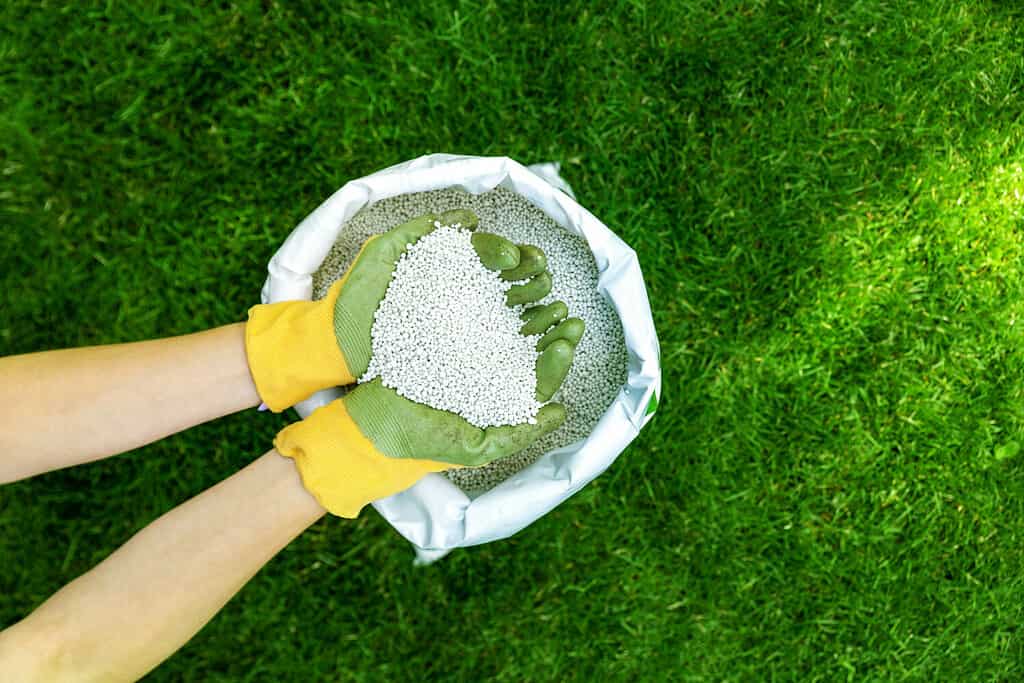
Nitrogen and iron-dense fertilizer can help your lawn flourish.
©ronstik/Shutterstock.com
Just like people, grass can have an iron deficiency. Yellow, uneven grass can result from an iron deficit, however, this is rather uncommon. In the colder months, Bermuda grass is going to become dormant, but around May, the grass should begin to turn green.
Check to make sure that your irrigation and fertilizer practices are perfect before doing anything else if it doesn’t appear lush and green. Then, you might want to consider including an iron supplement for your lawn.
Iron should only be used in the spring, between 60 and 70 °F.
Summary of Why Bermuda Grass is Dying
- It’s too cold
- Dense soil
- Dollar spot fungus
- Not enough sunlight
- Grass disease
- Spring dead spot
- Insect infestation
- Fertilizer burn
- Nutrient deficiencies
The photo featured at the top of this post is © Joyjiraporn/Shutterstock.com
Thank you for reading! Have some feedback for us? Contact the AZ Animals editorial team.







